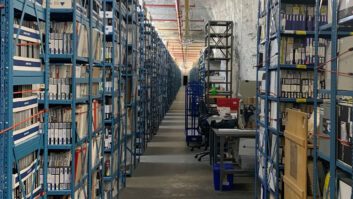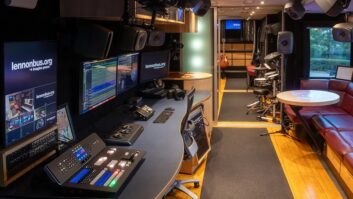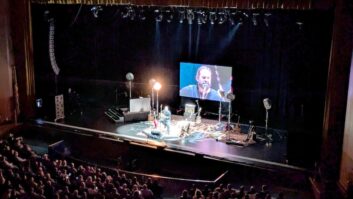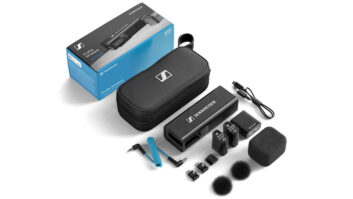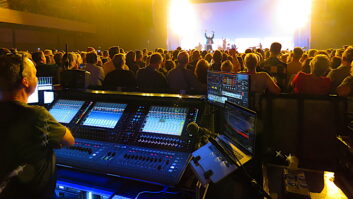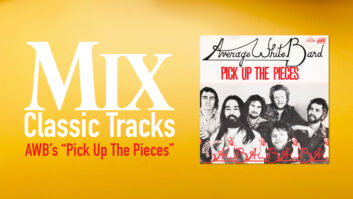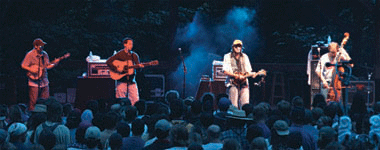
Just as one should never judge a book by its cover, one should never prejudge a performance by its stage. On the evening of February 24, 2005, someone unfamiliar with the Yonder Mountain String Band could have easily walked into Greensboro, N.C.’s historic Carolina Theatre, glanced upon the ornately trimmed 1920s-era stage and assumed that the evening would be filled with tranquil acoustic sounds. Dimly lit and occupied by four vocal microphone stands, two instrument mics and four evenly spaced racks of gear, the stage simply did not foreshadow the impending intensity of the evening’s performance.
Yonder Mountain String Band (Adam Aijala, acoustic guitar; Jeff Austin, mandolin; Dave Johnston, banjo; and Ben Kaufmann, upright bass) and their crew must be used to such erroneous assumptions by now. After all, quartets featuring banjo, acoustic guitar, mandolin and upright bass rarely attract rabid fans that uninhibitedly dance and sing in the aisles — or with tonight’s show, in the orchestra pit — from the show’s very first note. But the difference between this band and most other bluegrass-influenced acoustic groups is that Yonder Mountain rocks — pure and simple.
MAKING AN ACOUSTIC ACT LOUD
According to front-of-house engineer Ben Hines, his job with Yonder Mountain String Band is pursuing the high levels before feedback — a tough task for an acoustic act generating virtually no onstage volume. “We’ve gained the ‘jam band’ title and a rock ‘n’ roll crowd,” he explains. “I’m basically pushing toward the last five percent before feedback to get these meaty volumes that the crowds are expecting — and I have zero stage volume. Basically, I’m 100 percent out of the speakers.”
Long before his gig with Yonder Mountain, Hines began his career as a musician and later attended Eastern Kentucky University on a Music Education scholarship for trombone. “While I was there, I realized that I didn’t have the nerve to perform onstage,” he admits with a laugh. “I then decided to get into electronic music and moved to Dayton, Ohio, to go to the International College of Broadcasting. They had a small audio recording program there.”
Prompted by the encouragement of an ICB instructor, Hines soon took a job at a local 200-seat club — the Canal Street Tavern — where he began to hone his skills as a live sound engineer. “I got thrown into the fire there,” he recalls. Hines continued to work various house sound gigs until finally — albeit briefly — moving to Austin. “It was October 2000 and I was working at Big House Sound when the [Yonder Mountain] guys called me. Previously, I had a house gig in a 400-seat venue in Kentucky where I had mixed them. I remember that they really enjoyed the way I mixed, and after the show, I gave them a business card. Later when I got that call, I was humping P.A. in the hot Texas heat so I said, ‘Yeah, I’ll take that gig!’”
Monitor engineer Kevin Gregory (left) and FOH engineer Ben Hines in front of the new Midas board
Since then, Hines has enjoyed Yonder Mountain’s growing success, moving from “sleeping on floors and driving all night” to traveling as any hot ticket act should — on a large, comfortable Prevost touring coach. But to Hines, the best thing about his gig is the constant musical surprises, courtesy of the highly improvisational musicians he collaborates with every night.“I obviously don’t hear the same show every night, which is what you’d get when working with other bands,” Hines offers. “They do weird segues, go into different songs and I feel that I’m in tune with what the guys are doing onstage. They definitely make me feel like I’m part of the band.”
Yonder Mountain recently acquired a new Midas Verona 4008 for FOH, which Hines adores. “I had fallen in love with anything made by Midas, and because we don’t have a major-label budget, everything is financed in-house,” he says. “We were looking closely at price. I had worked on the Heritage, the Venice and a couple of Veronas. While the Veronas didn’t have all the bells and whistles of the others, it had those great Midas preamps. Plus, this console fits nicely under the bus; they don’t have to travel with a trailer.”In regards to processing, Hines cites the BSS DPR-404 quad compressor/de-esser, Rane Model DC-24 dynamic controller and BSS FCS 966 Opal graphic EQ as the most crucial bits of gear in his racks. “I use the DPR-404 for vocals and the Rane DC-24 with the crossed-over compression for bass,” he explains. “I have the BSS Opal graphic EQ on both of my guitar channels, which gives me a great acoustic sound. Adam plays semi-light, so I take the tinny-ness out of his pickup channel and use the lows while graphic EQ’ing out the high part of his acoustic’s internal mic. It turns out to be a really nice blend.”Onstage, Aijala and Austin use rack-mounted Pendulum SPS-1 stereo preamps in their respective racks and internal Joe Mills acoustic instrument mics. In addition, Austin frequently steps up to a stand-mounted Neumann KMS 105 for solos, which is phase-corrected with a Little Labs IBP alignment tool. Banjo player Johnston uses an internal pickup/external Shure SM98 combination with an Avalon U5 mic preamplifier. Kaufmann’s Eminence Gelbass — a miniature acoustic upright bass with standard-size neck and scale length — runs direct via two bridge-mounted pickups. “Those things give me a consistent sound everywhere I go,” Hines boasts.Everyone sings both lead and backing vocals, all using Shure SM87A mics. “Most songs — at a minimum — are two-part harmony,” says Hines. “But everyone sings, sometimes in four parts.”On this particular night, a P.A. featuring Meyer Sound UPA-1A speakers and Crest Audio FA-901 amplifiers was used. However, this varies from show to show, as Yonder Mountain relies on house systems. This often presents extra challenges for Hines, who says that some venues simply “don’t get it.” “The last thing I want to hear is, ‘You’re not a rock band so you don’t need a big P.A.’ It’s a complete misunderstanding.” On some occasions, Hines supplements the house system with additional front-fill and sub cabinets. “One of the next purchases I’ll make is front-fills, probably the Meyer Sound UPM-1P models. That will make sure that I always sufficiently cover the front rows.”
For Yonder Mountain’s “no wedges” monitoring situation, recently appointed monitor engineer Kevin Gregory mixes on a Crest Audio XRM rack-mount mixer for the band’s Shure personal monitoring systems, which comprise two PSM600 and two PSM700 packages. “It’s pretty straightforward,” says Gregory. “By using in-ears with acoustic instruments, we eliminate a lot of the inherent feedback problems of using monitors. I may have the same ear mix ready each night, but it will change because of the way it reacts with the room’s size and acoustics.”“If your gain’s too hot, you’ll get so much slapback inside the instruments that it will cause a wash in the band’s ears,” offers Hines, explaining how FOH can drastically affect the band’s mix. “The main thing the band hears from the mains is the highs, so we roll 5 kHz out of their ears.” Recently, the band noticed an improvement in their monitor mixes, says Hines, because of the new FOH desk. “They would occasionally ask me if the new console had anything to do with the monitors, and I would say, ‘Nope.’ But when we started using the Verona, they could hear a lot better — they’re even playing better!”Along with keeping levels at an optimum point — hot, but not too hot — Hines feels that getting good separation is a significant nightly job. “I don’t do hard compression on anything because I think that takes a bit too much life out of each instrument,” he says. “I do some cuts at front of house with graphic EQ, but the way the preamps come up, as long as I have good, strong gain, I will add frequencies instead of getting rid of them. There are some drastic cuts at 160 Hz and 400 Hz for guitar, but I make those up in the mandolin, where I add 400 Hz. I try to fill four parts of the EQ spectrum with the four instruments. Since all of those strings are so close to each other, getting separation is important.”Hines confirms that aside from all of the technical and acoustics considerations of his job, it is fan participation that makes for a perfect performance. Judging from the Carolina Theatre crowd’s spirited orchestra pit jigs and transfixed attentions, Yonder Mountain nailed it. “It’s all about crowd reaction,” Hines concludes. “A perfect show is where we can get to a loud point with the crowd in a complete frenzy, and one of the guys stops and starts tickling the instrument. Then it’s dead silence. That’s when you know everyone’s into the show.”Strother Bullins is a North Carolina-based freelance writer specializing in the pro audio, music and entertainment industries.
OUR STORY TAKES PLACE WITH A NEW VERONA
HANDS OFF THE WEDGES
